




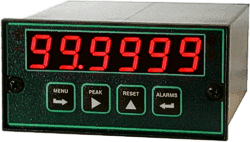

Dual relay outputs (two relays) or quad relay outputs (four relays) are available as an option in all Laureate 1/8 DIN digital panel meters, counters, timers, and serial input meters. Multiple alarm and control modes can be implemented by these relays around two programmable setpoints. The relays can be Form C contact relays or Form A solid state relays.
The Form C contact relays are SPDT and are rated 8A at 250 Vac or 24 Vdc. Contact relays are required to switch high currents.
The Form A solid state relays are SPST and are rated 120 mA at 140 Vac or 180 Vdc. Solid state relays are ideal for low switching currents and frequent operation.
Dual solid state relays (two relays) are standard in Laureate 4-20 mA & RS485 DIN rail transmitters and 4-20 mA & Ethernet transmitters.
For additional relay information, please see our setpoint control page.
| Normal, Non-Latched Operation | |
|---|---|
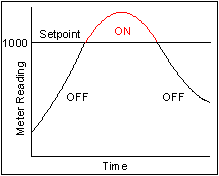 |
In this mode, the relay closes when the reading rises above the setpoint and opens when the reading falls below the setpoint. Relay ON/OFF control action is independently programmable for each of the two relays and can be reversed through a setup command. |
| Latched Operation | |
 |
The relay stays actuated until reset externally. This mode can be used to shut down machinery or a process when an operating limit has been exceeded, or to maintain an alarm until acknowledged by an operator when the alarm condition has passed. |
| Mixed Latched and Non-Latched Operation | |
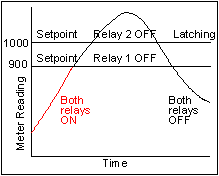 |
One of the relays can operate in a non-latched mode, for instance to turn off a heater when an operating temperature setpoint is reached. The other relay can operate as a latching fail-safe backup and turn off the entire process when a second, higher setpoint is reached, indicating a malfunction. |
| Deviation Mode Operation | |
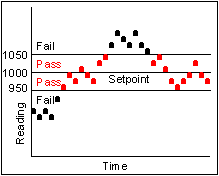 |
A deviation limit (50 in this example) is set up around both sides of the setpoint. The relay closes (or opens) when the reading falls within the deviation band, and opens (or closes) when the reading falls outside of this band. This mode sets up a passband around the setpoint and is often used for component testing. |
| Wide Hysteresis Mode Operation | |
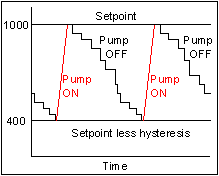 |
In this example, a hysteresis limit of 600 is set below the setpoint. The relay closes when the reading reaches a lower limit (the setpoint less hysteresis) and opens when the reading reaches an upper limit (the setpoint). One application is automatic tank filling. A fill operation is automatically initiated when the tank level has reached a lower level and is terminated when the level has reached an upper level. |
| Narrow Hysteresis Mode Operation | |
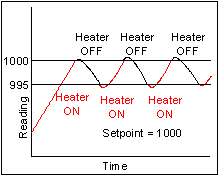 |
Hysteresis can be used to minimize the number of ON/OFF control cycles around a setpoint, thereby increasing the life of motors, relays, etc. A very narrow hysteresis band (such as 5 counts) can also be used to minimize relay chatter around a setpoint due to electrical noise on the signal, or due to signal feedback caused by load switching. The hysteresis limit should exceed the noise amplitude. |
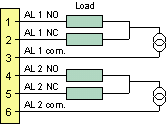
|
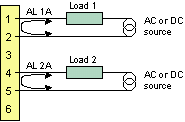
|
| Dual contact relays. Each load load rated 8A at 250 Vac or 8A at 24 Vdc. | Solid state, AC or bidirectional DC connection with 2 loads. Each load rated 120 mA at 125 Vac, or 240 mA at 150 Vdc, 20 ohms series resistance. |
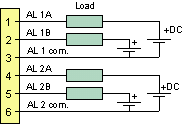
|
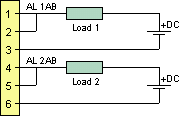
|
| Solid state, DC connection with 4 loads. Each load rated up to 240 mA at 150 Vdc, 10 ohms series resistance. | Solid state, DC connection with 2 loads. Each load rated up to 250 mA at 150 Vdc, 5 ohms series resistance. |